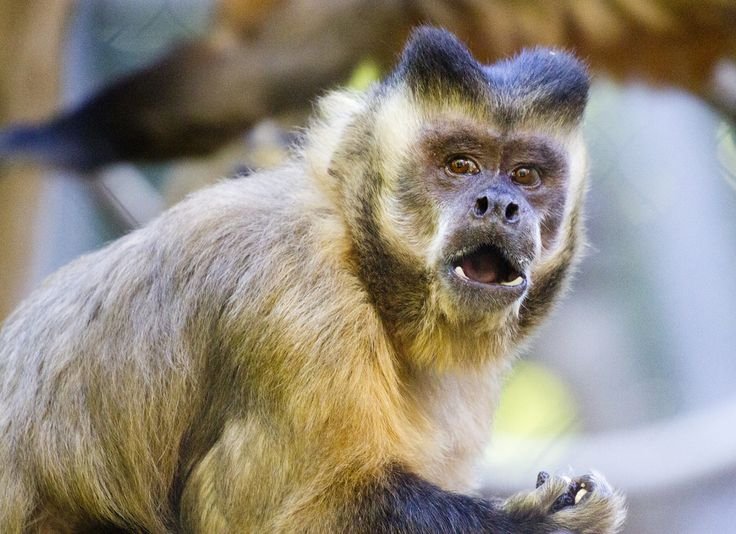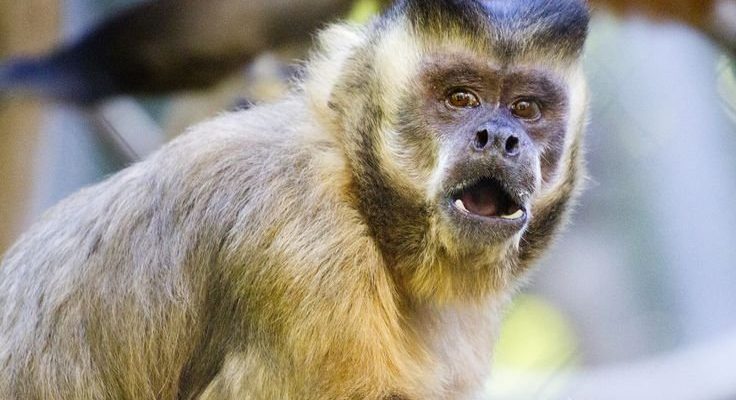
Understanding these creatures not only deepens your appreciation for the animal kingdom but also sharpens your skills for identifying them. Just like how different dog breeds can share similar traits while being distinctly unique, many primates have overlapping characteristics. Let’s dive into this world of similarities and differences, so the next time you come across a tufted capuchin or its cousins, you can recognize them with confidence.
1. Squirrel Monkey
One of the best-known relatives of the tufted capuchin is the squirrel monkey. These small monkeys are lively and agile, just like their tufted cousins. You might spot them darting through the trees, chattering away in their playful, social groups. With their large, expressive eyes and short limbs, they’re a joy to watch.
To tell them apart, look closely at their fur. Squirrel monkeys typically have distinct yellow-orange coats with a lighter belly, while tufted capuchins sport a darker color. Moreover, the tufted capuchin has a noticeable tuft of hair on its head, which adds to its distinctive look. The squirrel monkey, on the other hand, has a more uniform appearance without such a tuft.
2. Black-Capped Capuchin
Another close relative is the black-capped capuchin. This primate can be found in similar habitats as the tufted capuchin, which sometimes leads to confusion. These monkeys have a similar body structure, but one of the biggest giveaways is their fur. The black-capped capuchin, as its name suggests, has a dark cap of fur on its head, while the tufted capuchin has lighter fur with a unique tuft.
Both species are intelligent and social, often seen foraging together. However, the black-capped capuchin tends to have a more even temperament. If you watch them closely, you might notice the tufted capuchin’s more playful and mischievous nature, which contrasts with the slightly calmer demeanor of the black-capped variety.
3. Howler Monkey
You might recognize the howler monkey by its distinctive vocalizations, which can be heard from miles away! While howler monkeys are typically larger than tufted capuchins, they also inhabit overlapping regions, making it easy to confuse the two. Their long limbs and prehensile tails help them swing gracefully through trees, much like their smaller relatives.
To differentiate them, pay attention to their size and noise. Howler monkeys are some of the largest monkeys in Central and South America and are known for their impressive howling calls. In contrast, tufted capuchins are more agile and less loud. While both monkeys are social, howler monkeys often engage in more territorial displays and can be found in larger family groups.
4. Common Marmoset
When it comes to tiny primates, the common marmoset deserves a mention. These diminutive creatures pack a lot of personality into their small frames. Marmosets are primarily found in the forests of Brazil, just like tufted capuchins. Although they share the same habitat, they differ significantly in appearance and behavior.
Marmosets have a unique look with their fluffy white ear tufts and small size. They usually weigh less than a pound! In contrast, tufted capuchins are larger, with more robust bodies and darker fur. Pay attention to their social behavior too. While tufted capuchins are more playful, common marmosets often have a more subdued social structure, leaning into family ties.
5. Brown Capuchin
The brown capuchin is yet another similar species worth noting. This monkey shares many behavioral traits with the tufted capuchin, such as intelligence and playfulness. Found in the same regions, it’s easy to see why they might be confused.
However, the brown capuchin’s fur is predominantly brown or light tan, lacking the distinctive tuft of the tufted capuchin. You can also note that brown capuchins tend to have a more uniform coloration across their bodies. If you see a group of these monkeys, pay attention to their movements—they often engage in more complex social interactions compared to their tufted relatives.
6. Mantled Howler Monkey
Regionally close to the tufted capuchin is the mantled howler monkey. These monkeys are notable for their long, silky fur, which drapes down like a mane, giving them a distinctive appearance. They inhabit the same forested areas, so spotting them together might lead to some mix-ups.
What sets them apart is their size and look. Mantled howlers are larger and have a more pronounced howling call compared to tufted capuchins. If you notice a monkey with a longer body and a deep voice, you’re likely looking at a mantled howler. Honestly, the contrast in their vocalizations is a good cue: tufted capuchins are much quieter.
7. Woolly Monkey
Woolly monkeys are another larger relative that you might encounter in the same regions as tufted capuchins. With their thick, curly fur and robust build, they might remind you of a small teddy bear. Woolly monkeys have strong arms that help them swing gracefully through trees, but their larger size sets them apart from the tufted capuchin.
To distinguish them, focus on their fur texture and build. Woolly monkeys have a much stockier body and typically lighter-colored fur. If you’re observing social behavior, woolly monkeys tend to be less playful and more laid-back than the energetic tufted capuchins.
8. Spider Monkey
When speaking of agility and cleverness, the spider monkey is hard to overlook. Known for their long limbs and tails, these monkeys are some of the best acrobats in the primate world. They share habitats with tufted capuchins, which can make differentiation tricky.
The most noticeable difference is in their tails. Spider monkeys have long, prehensile tails they use almost like a fifth limb. In contrast, tufted capuchins have shorter tails, which they do not use for gripping. Visually, spider monkeys tend to have a more slender appearance compared to tufted capuchins’ stockier build.
9. Pygmy Marmoset
As one of the smallest monkeys in the world, the pygmy marmoset is a delightful miniature version of its larger relatives. You might spot these tiny critters in the same South American forests as tufted capuchins, but they are significantly smaller, often weighing less than a pound.
While both are social, pygmy marmosets have a more unique lifestyle. They often form smaller family units and communicate through high-pitched calls. Their fur is also distinctly softer and fluffier compared to the tufted capuchin’s coarser hair. If you see a monkey more the size of a kitten, you’re definitely looking at a pygmy marmoset!
10. Tamarin Monkeys
Finally, let’s not forget the tamarins, particularly the golden lion tamarin. These monkeys are visually striking with their vibrant fur and playful demeanor. They inhabit similar ecosystems as the tufted capuchin but can be distinguished by their unique appearance and social behavior.
Tamarins have a more compact build and striking coloration. For example, golden lion tamarins have a bright orange and black coat, unlike the more subdued color palette of tufted capuchins. If you see a monkey with an unmistakable mane and lively personality, you might just be observing a tamarin!
Throughout this discussion, we’ve explored various animals similar to the tufted capuchin and how to differentiate between them. With their unique features and traits, it’s easier than ever to appreciate the rich diversity in the primate world.
In conclusion, the tufted capuchin is just one small part of a much bigger picture. By recognizing the characteristics of its closest relatives, you enrich your understanding of them and their habitats. Next time you find yourself in a jungle or wildlife park, you’ll be ready to make quick and accurate distinctions among these captivating creatures!

